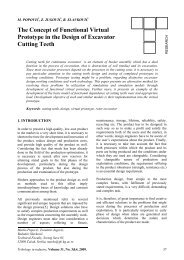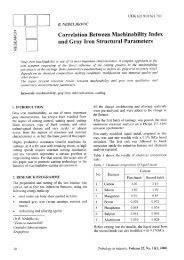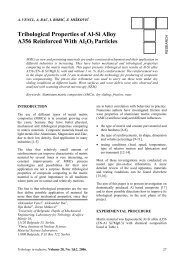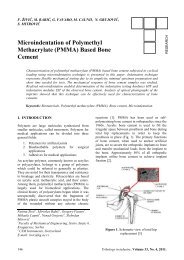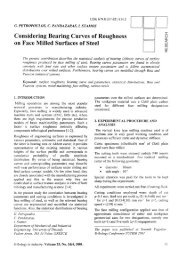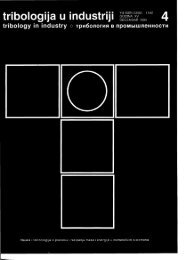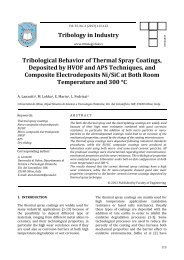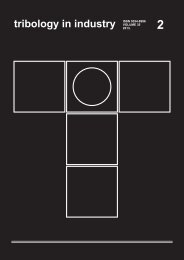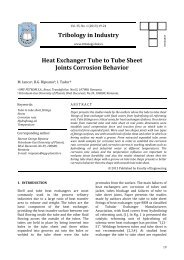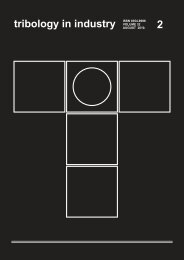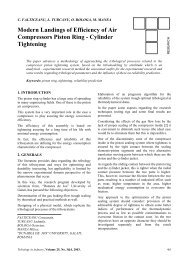No. 1, 1998 - Tribology in Industry
No. 1, 1998 - Tribology in Industry
No. 1, 1998 - Tribology in Industry
You also want an ePaper? Increase the reach of your titles
YUMPU automatically turns print PDFs into web optimized ePapers that Google loves.
sign parameters. They represent the bounderry conditions<br />
which are basis for the computation of dimensions.<br />
As here are several conditions and the design parameters<br />
should satisfy all limitations <strong>in</strong> an opt<strong>in</strong>ral way. Thc<br />
optimisation model is developed for that purpose and its<br />
basic scherne is shown <strong>in</strong> Fig. 4. Design parametrs of<br />
seal<strong>in</strong>g connections such as diameters. thickness, lengths<br />
and material characteristics are narked as17, x2) xJ ... xn<br />
and they represent the vector of <strong>in</strong>dependent variables<br />
X( x1, xv x3, ...x;. Limitations such as resistance fclrces,<br />
stress, fluid leakage, wear, etc. depend on these parametersxT,<br />
x) x3, ... r1, and on operat<strong>in</strong>g conditions (pressure,<br />
temperature, velocity, etc.). These limitations are marked<br />
asg;(x7, x) x3, ...x,,,) and they def<strong>in</strong>e the optimisation<br />
range D(x7, .r3 J-1, ....r,,) from which the optimal set of<br />
parameters is selected. The oljective function/(x7, x) xJt<br />
...,r;,,)<br />
should be the marimum seruice life for that seal.<br />
The result of this optimisiition process is the vector of<br />
optrmal variables X(xb x2, x3,... ;,,) which belongs to the<br />
optimisation rarnge D(x7, xj x3, ... r,,) and which satisfies<br />
the objective function.f,<br />
5. MODEL OF THE DESIGN PROCESS<br />
OF SEALING CONNECTIONS<br />
The modell<strong>in</strong>g makes possible highlight those characteristics<br />
of objects which are important for the entire<br />
analysis, to make certa<strong>in</strong> transforn.rations and simulations<br />
and to drarv out the conclusions. Models are extensively<br />
used <strong>in</strong> the design process and they represent the<br />
language of designers. In Fig. 2 the basic operations <strong>in</strong><br />
the develop<strong>in</strong>g process of seal<strong>in</strong>g elements are shown<br />
ancl <strong>in</strong> Fig. 5 the corrplete model rvith all its modules and<br />
knowledge datahasc is given. The design process is performed<br />
through analvsis and svnthesis.<br />
Analysis is the proces.s *,hii:h proviCes data and knowledge<br />
necessary for the further development of the clesign<br />
process.'l'ire knowledge ciatahase represents the organised<br />
set of data. calculation ancl analytical procedures.<br />
The operations and activities that permit the transformation<br />
of data and knowleclge <strong>in</strong>to the basic design <strong>in</strong>formation<br />
nrake the <strong>in</strong>fomtation nodule. In the synthesis<br />
the digested <strong>in</strong>formation is userl for build<strong>in</strong>g the model<br />
of product. This process takes from the database <strong>in</strong>dividual<br />
general design elements of seal<strong>in</strong>g connections. The<br />
module for the selection of a seal, shown <strong>in</strong> Fig. 3, is used<br />
with<strong>in</strong> the genertrl jnformation module and synthesis<br />
procedure. It features iis a separate entity and the follow<strong>in</strong>c<br />
calculations are perfornred accord<strong>in</strong>g to the algorithms<br />
which are classified <strong>in</strong> the knowledue datal;ase.<br />
Gener;rl schenre of the opt<strong>in</strong>risation model for seal<strong>in</strong>g<br />
elernents is shorvn <strong>in</strong> Fig. 4. The design elements are<br />
those parts of seal<strong>in</strong>g elenents which are used <strong>in</strong> different<br />
arransements. They might be developed as parametric<br />
nrodels, so by change of parameters the elements<br />
could be adapted for the clifferent uses and conditions.<br />
The design elements could be also constructed <strong>in</strong> a mo-<br />
Cpl<strong>in</strong>risolion ronge<br />
D (*.,, *a, *3, ......rn)<br />
Resisionce<br />
seol<strong>in</strong>g io<strong>in</strong>ts<br />
t=rtx. . x... x- -<br />
l' 1' J'<br />
Obieclive function<br />
t (xt, X2, XJ, ......"n)<br />
Stress<br />
o =o(xr<br />
Leokoge of fluid<br />
Q=Q(x,, *2, rJ,......rn)<br />
Weo r<br />
Ah=Ah(x 1,<br />
Optimunr volue<br />
of secl<strong>in</strong>g paroixeiers<br />
X(r ., x _., x _, ......x )<br />
lzl Jn<br />
Fig. 4. T-ltc opt<strong>in</strong>titatiort :cltutrc of dcsign Tiaratttctars oJ'seulittg jo<strong>in</strong>ts<br />
30 fiibologt irt ittiluslry, Volunre 20, <strong>No</strong>. 1, <strong>1998</strong>.



